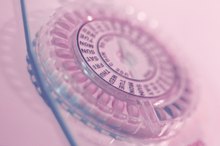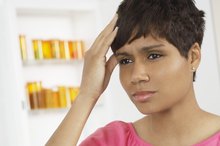The absence of menstrual periods, medically known as amenorrhea, can occur as a primary or secondary disorder. Both primary amenorrhea, the absence of menstrual periods by age 16, and secondary amenorrhea, cessation of periods after menstruation has begun, often occur because estrogen levels fall below normal. Low estrogen levels may also affect vitamin D’s ability to facilitate calcium absorption, which can lead to bone loss, explains nurse practitioner Marcelle Pick on the website Women to Women. Women with severe vitamin D deficiency in addition to amenorrhea may suffer from osteoporosis and increased fracture risk.
Causes
Vitamin D deficiency and amenorrhea may both occur because of poor diet, anorexia and malnutrition. Vitamin D is found primarily in meat and fortified dairy products, foods often avoided by women, especially teens, trying to watch their weight.
Concerns
Muscle Loss in Women Over 50
Learn More
Post-menopausal women develop osteoporosis because estrogen helps build new bone. When estrogen levels fall in menopause, more bone loss than bone building occurs, resulting in a decrease in bone density. This drop in bone building also occurs in women with amenorrhea. Low estrogen decreases vitamin’s D effectiveness, so a vitamin D deficiency can worsen the bone loss that occurs because of amenorrhea.
- Post-menopausal women develop osteoporosis because estrogen helps build new bone.
- When estrogen levels fall in menopause, more bone loss than bone building occurs, resulting in a decrease in bone density.
Symptoms
Both low estrogen levels and vitamin D deficiency can cause:
- fatigue
- sleep problems
- decreased energy levels
- depression
- muscle pain
- increased fracture risk
Diagnosis
Menopause & Thickening of Uterine Walls
Learn More
Amenorrhea is easily diagnosed, but diagnosing low estrogen levels causing amenorrhea requires blood tests. Blood tests also diagnose vitamin D deficiency. Pick states that a serum level of 50 to 70 nanograms per milliliter, or ng/mL, of vitamin D is optimal, but that most practitioners feel a level of 20 to 50 ng/mL is within normal limits.
Treatment
Women or girls with amenorrhea need calcium and vitamin D supplementation to prevent bone loss. This is especially important if they also have a vitamin D deficiency.
Always discuss supplementation with your medical practitioner before taking more than the daily recommended dose of vitamin D. Sun exposure can also increase vitamin D levels, but discuss how much sun exposure you should have with your medical practitioner as well.
Related Articles
References
- University of Rochester Medical Center:Menopause and Osteoporosis
- U.S. Department of Health and Human Services: Vitamin D Guidelines
- Nazem TG, Ackerman KE. The female athlete triad. Sports Health. 2012;4(4):302-11. doi:10.1177/1941738112439685
- Agarwal A, Aponte-Mellado A, Premkumar BJ, Shaman A, Gupta S. The effects of oxidative stress on female reproduction: a review. Reprod Biol Endocrinol. 2012;10:49. doi:10.1186/1477-7827-10-49
- Carter S. Female Athlete Triad/Relative Energy Deficiency in Sport: A Perspective Interview With Professor Barbara Drinkwater. Int J Sport Nutr Exerc Metab. 2018;28(4):332-334. doi:10.1123/ijsnem.2018-0030
Writer Bio
A registered nurse with more than 25 years of experience in oncology, labor/delivery, neonatal intensive care, infertility and ophthalmology, Sharon Perkins has also coauthored and edited numerous health books for the Wiley "Dummies" series. Perkins also has extensive experience working in home health with medically fragile pediatric patients.









